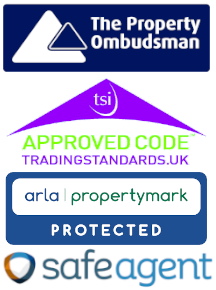
Is a tenant about to move out of your rental property? You may already be thinking about what you need to do to prepare the property for potential new tenants.
Ensure the move out procedure goes smoothly with our move out checklist.
Serving notice
If your tenant’s tenancy agreement is coming to an end, or if you’d like to reclaim possession of your rental property, you must serve notice to your tenants. Landlords can serve a Section 21 notice but have to give at least two months written notice prior to the end of their tenant’s agreement.
However, if your tenant wishes to serve notice on leaving your property, they also have to give a specific length of notice depending on the type of tenancy agreement they have. For example, if your tenant has a periodic tenancy, then they have to give at least one month’s notice of their intention to leave.
If you didn’t have a written agreement with your tenant and it was a rolling contract, then your tenant still has to give you either a month’s notice or 4 week’s notice depending on whether the tenancy is per month or week.
In some cases, you can serve a Section 8 notice which gives as little as two weeks notice. However, this is in the case of a tenant damaging a property or failing to pay rent.
Inspect the property
Before your tenant’s move out date, you or a property management company should take out an inspection of the property. This is so you can look for any potential damage or maintenance requirement that would need to be billed from your tenant’s deposit. It also gives you enough time to arrange for anything that need fixing within the property before your next tenant moves in.
It’s best to arrange the inspection when your tenant is available to be at the property too, so that you can discuss any issues together.
It is your tenant’s responsibility to ensure the property is returned to you in the same condition as at the start of the tenancy. However, you do need to take into account fair wear and tear which can vary depending on how long your tenant resided in the property and the quality of fittings and furniture.
You should inspect every room within the property and remember to document with photos as it will be useful should you need to dispute and demonstrate the damages caused to your tenant. Note down both wear as well as any more potentially significant damage.
Don’t forget to check:
As well as the inside of the property, ensure your tenant has properly maintained areas such as the garden or garage.
Check that all appliances are in working order, including smoke detectors, carbon monoxide detectors as well as kitchen and other electrical appliances.
You should also arrange for another inspection after your tenant has moved out so you can double check the condition against the inventory carried out on the move in date. This also gives the opportunity for you to ensure all appliances are working and safe, and if not, you can remedy ahead of your new tenant’s arrival.
Contact bill suppliers and the council
Although it’s mainly a tenant’s responsibility to contact their utility provider to notify them of their move out date, there’s no harm in you confirming with the bill companies on their behalf.
As part of your inspection of the property, you should take a final meter reading to check with the utility providers. This way you can ensure that your tenant has paid any potentially outstanding bills.
You should also check that your tenant has paid their final rent to you. Not only does this help to reduce any risk of unpaid bills arising, but if sorted quickly, it means the unpaid funds can simply be deducted from their deposit, rather than you having to pick up the bill instead.
Similarly, your tenant should notify the council tax of their change of address. However, it may be beneficial for you to contact the council yourself as you may be eligible for an ‘unoccupied property exemption’ on the council tax you pay. This is at the discretion of each local council though, and sometimes you can be charged double your usual council tax if your property has remained empty for more than two years.
Releasing your tenant’s deposit
After you have inspected the property and documented potential costs, you can claim this against your tenant’s deposit.
Things that can be claimed from your tenant’s deposit include unpaid rent, damage missing items and cleaning and maintenance costs.
You are responsible for returning your tenant’s deposit within 10 days once you come to an agreement on the amount. However, if there is a dispute over the amount, then the Tenancy Deposit Scheme will keep hold of the deposit until an agreement is reached.
Find tenants
The next step once your tenant has moved out, and you’ve ensured your property is safe and habitable, is to find tenants to fill your property. You can list your property with us. From our £12 a month Good Landlord package, to our Standard Package, we have a range of packages to suit your every need.
Some of our packages include advertising on Rightmove, Zoopla as well as our own platform, and our service can help you find tenants quickly with our average let time of just 12 days.
For when you have a new tenant moving in, make sure you check out our moving in checklist for more landlord tips!
We also offer a Check-Out service for £108 which can help take the stress away from the move out process and give you peace of mind. The check includes a full report on the property’s condition in comparison to the original inventory, and also includes key collection and requesting up to date meter readings.







